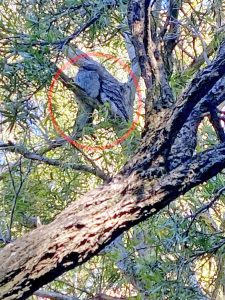By Andrew Wood, Convenor, Bulletin 7/2023, September

The Blue Wren Subcommittee has 13 members and met on seven occasions during 2022-2023. There are two volunteer bushcare groups that care for parks in our suburb – Judy Christie leads the Orphan School Creek Bushcare Group and Anna Szanto the Glebe Palmerston and Surrounds Landcare Group. Also, the Subcommittee keeps a watching brief over four other parks and the details are as follows: Rozelle Bay – David Lawrence, John Street Reserve — Norma Hawkins, Paddy Gray Reserve – Bryan Herden and Harold Park / Johnstons Creek – Janice and Nick Sangster. At the beginning of 2023, Judy Christie and Helen Randerson helped write the Society’s response to the City’s Street Tree Master Plan and Urban Forest Strategy.
The tenth annual Glebe/Forest Lodge spring bird survey, led by Judy Christie, was held from 6:30 am on 23 October 2022 and 18 participants counted birds in 10 different locations. Sightings were made across Glebe’s parks, trees and waterways, as well as on roofs, TV antennae, chimney pots, footpaths and busy traffic intersections. A total of 674 birds were seen, less than in 2021, likely due to the wet weather. More impressively, 33 different bird species were identified, equal to the highest diversity of species recorded over the last 10 years. The two most common birds were again the native Noisy Miner and the Rainbow Lorikeet.
The Noisy Miner continues to aggressively dominate all our open spaces and the Rainbow Lorikeet is likely to be the most common urban bird in Australia. Our Magpies are also breeding up, selecting tall trees for their nests. Two other native species whose numbers are increasing are the Grey Butcherbird and Laughing Kookaburra. Both these species, with characteristic calls, can be predatory on nestlings of other birds. It will be no surprise to residents that the Brush-Turkey has now made our spring survey as well. A large flock of Sulphur-crested Cockatoos was more of a surprise, as usually only one or two are seen on our annual surveys. A Tawny Frogmouth (see photo) was a great find and although nesting at the Annandale end of the park, they may well frequent our street-lights for insects over the summer nights. The only small bird was a Willie Wagtail calling from a barge in Rozelle Bay. Once again, we had a birdwatchers’ breakfast celebration at Esca to conclude our morning’s activities.

In November 2022, applications for Craney Small Grants to foster the teaching and learning of biodiversity were sent to the 14 local preschools and schools in our suburb. The grants program was initially funded by a bequest from Jan Craney who was particularly interested in the education of young people to increase their awareness of the value of native plants and animals. Further generous donations to the Subcommittee have permitted the program to continue. The successful applicants were Glebe Public School (a grant of $1,700 awarded for a project entitled ‘Glebe Public School Environment Project’) and The Crescent Early Learning (a grant of $600 for a project entitled ‘Helping Bees Thrive’). On completing their projects, the applicants have been asked to write a report of about 300 words, accompanied by a photograph, for publication in the Society’s Bulletin and on the website.
A highlight of the year was the award in November 2022 of $40K to the Society for an Innovation and Ideas Grant from the City; the grant application was written by the Subcommittee and was entitled ‘Glebe’s Hill – unravelling its biodiversity secrets and potential’. The Hill is a 0.6Ha site of contaminated crown land lying between the Tramsheds and the light rail line. The aim of the Grant is to fund observations by the University of Sydney in which they will place wildlife monitors and perform walk-throughs to study urban fauna and flora at five sites in the local Government area (LGA) including Glebe’s Hill. The results of the studies will help determine whether Glebe’s Hill could eventually become the City’s first urban wildlife refuge. Although a grant contract was promptly signed between the City and the Society, there was a six month’s delay in signing the contract between the University and the Society. After submitting an application to the City in January 2023 for a Licensing Agreement to permit the University to access the LGA sites and commence its research, it now appears that the Agreement will not be ready for the Society’s signature until September 2023.

On Sunday 7 May 2023, the Society organised a public information session at the Tramsheds Community Hall about the planned research to be funded by the grant; nearly 100 residents attended. The Lord Mayor, Councillor Clover Moore, attended and spoke about the City’s grant program and the City’s recent capital expenditure in Glebe. Other speakers were Dr James Macnamara, the City’s Urban Ecology Coordinator (‘Biodiversity potentials for the City of Sydney’), Max Solling, Glebe Society member and local historian (‘Recent history of the Hill’) and Andrew Wood, Convenor of the Society’s Blue Wren Subcommittee (‘Background and overview of the Glebe Society’s Innovation and Ideas Grant’). Then Professor Dieter Hochuli, leader of the University of Sydney’s Integrative Ecology Group, described his plans for ‘Establishing the Hill’s Biodiversity’ including the use of camera traps, acoustic monitors, remote sensing and in-person surveys. The talks were followed by afternoon tea.
Society members and their friends are always welcome to join the Subcommittee and to help with its bushcare activities (please feel free to contact us at bluewrens@glebesociety.org.au).










There are no comments yet. Please leave yours.